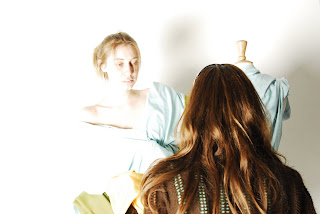I, a first time painter (putting it in print made me uneasy!) have begun my research into our classes final assignment. A few boxes, a stump and an violently colorful self portrait is the trail that leads me to this project.
When our instructor, for those of you who are here by accident, Marcelo asked us to construct a Tableaux Vivant, my facial expression dissentigrated from excitement to confusion. The exotic sound of it threw me off, even though I speak french. The modern humans interacting with classic paintings - a language I do not speak.
But I ascertained enough information to begin the process. The process, yes the process. Maybe if i say process 40 times I'll get an automatic A :) - for the blog at least.
I was initially tempted to select a modern artist – I know I would passionately recreate vibrant colors, especially when coupled with human forms of some kinda - Munch came to mind.
This is mainly due to the fact that whenever I see renaissance work I am immediately put off. The subjects (religious mostly) would bore me and the enchantment surrounding the scenes never stirred a deep movement inside me. The scale and detail of the works of Michaelangelo and his contemporaries are meant to intimidate and awe the audience, especially the ones they were targeting at the time. But that contrast in expected reaction and my own is the very reason I could never connect with the work.
However, bieng infinitely excited about all thing painting, it is specifically due to my ignorance that I’ve chosen Caravaggio.
Out of all the 15th century painters he was the only one whose paintings contained some hint of contempt and a slight bitterness towards his own work and subject matter. I might be wrong, but until my research proves otherwise – I think his dramatic manner disguises the sarcasm he feels towards religion. I can relate to that and that’s a good place to begin any painting.
So in my own “Italian Idol” search for the best painting from his selection, the following stood out.

Narcissus (1588 – 99) Oil on Canvas (110 x 92 cm)
“Narcissus” is a charming way to depict vanity, but the reflection in the water or whatever liquid is too advanced for the stage of painting that I currently reside in. If this were a direct recreation I would have less trouble, but since it is staged I sense my own rendition would lack the substance present here. I know that if I attempted this technique this early on in my art studies I would do a less than ideal job and proceed to be discouraged in future reflective paintings. Moving on *looking in mirror*
href="https://blogger.googleusercontent.com/img/b/R29vZ2xl/AVvXsEhgTskHEuQWKhzLsIa6NUakRk7QOwZai5JWA4G7EWq5sN7ihG4iJUtckp9NRs4kDKUkJ582YklRaVPijgWgwDxQN4UiV7eGQ5bxOdpiy895cV4CNt2ZZ4qiPRftLSciesekknaoF1gz_wc/s1600-h/800px-Judith_Beheading_Holofernes_by_Caravaggio.jpg">

Judith Beheading Holofernes (c.1598) Oil on Canvas (145 x 195 cm)
“Judith Beheading Holofernes” - are you kidding me? In one month? Marcelo would behead me for lack of talent.

Bacchus (c.1956) Oil on Canvas (95 x 85 cm)
“Bacchus” I confess, has some strange hold over my perception. He’s mesmerizing, even though he’s not really my type :) This would be relatively easy to stage, but one thing I love about paintings which is absent in self portraits or portraits – especially Caravaggio’s – is the interaction between two or more human forms. He uses light to create the conversation and atmosphere that take place in the scene and I didn’t want to miss an opportunity to tune into that wavelength, which explains my choice.

“Martha and Mary Magdalene” was the winner. It wasn’t a superficial choice as my explanation demonstrated there was a progression of thoughts and preferences in Caravaggio’s work that drew me to this image. I did note; however, that my selection of his work was restricted to his earlier paintings. So I learnt something new about myself. Now I can pretentiously say this statement at dinner parties: “Caravaggio? I prefer his work before 1598. I feel that his paintings got slightly out of control and less loving. They got angrier on average and I sensed he was painting as he could so well that it was almost his middle finger to the art community”. I’ll paraphrase it. The major appeal of this work is the fabric and tone. I can’t wait to stage the scene with some beautiful costumes.
c. 1598
Oil on canvas, 97,8 x 132,7 cm
Even though I’ve selected my work – the questions have only begun. For instance, back then there was no “Emirates Trading” to go buy your standard sized canvas. How am I going to recreate a canvas whose proportions have 0.8 and 0.7 in them? How do I apply the oil to get that smooth blended effect? Where do I get renaissance clothing from?
I will ask and see where that leads me. And now…onto more research.




























